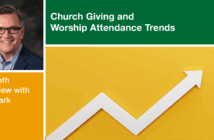Ann Michel, Doug Powe, and Jessica Anschutz of the Lewis Center staff identify seven trends church leaders should keep in mind as they develop creative ministries to reach new people in 2024. Many of these trends are daunting, reflecting the long-term decline in worship attendance and the increasing percentage of Americans who claim no religious affiliation. But there are also glimmers of hope in giving trends, in the emergence of new, more nimble, often smaller, models of ministry, and in the expanding opportunities for laypersons to minister in meaningful ways.
The pandemic has released its grip on our day-to-day activities. And yet, for many churches, “back to normal” hasn’t been quite what we hoped. This is true in large part because worship attendance and levels of church participation were on a trajectory of decline long before the onset of the pandemic. And this reality continues to strain our long-standing ministry models and institutional structures. These seven trends indicate that at the dawn of 2024 we are still in a liminal space in which many of our institutional structures and standard paradigms of ministry are showing themselves to be inadequate to the challenges of the day. Yet, the winds of change that buffet the church also bring the opportunity to embrace new, more innovative and relational ways of connecting with people, and the opportunity to equip new types of leaders.
1. Mainline malaise
Although U.S. churches across the denominational and theological spectrum are now impacted by declining attendance, symptoms of decline are most acute in mainline denominations where the onset of decline came much earlier for a variety of reasons, including underlying demographic differences impacting the relative strength of different segments of the Church in the U.S. While many mainline congregations and denominations are still buoyed by their assets and other institutional resources, their “brand” holds considerably less sway among religious seekers and in the public square. The typical mainline congregation is facing the need to adjust its expectations and ministry models. And mainline denominations face a need to realign their institutional infrastructure, including everything from judicatories and church agencies to theological education and parachurch organizations, to conform to current realities.2. Stable finances
Churches face many challenges in the current environment, yet a mounting body of evidence suggests the financial condition of most congregations remains surprisingly strong. For example, recent research assessing the impact of the pandemic on congregations and faith communities found that the median income of churches has increased 42% (25% when adjusted for inflation) since 2020. The same study found that the more a church’s giving came through online and electronic gifts, the higher their income, suggesting the pandemic-inspired shift to electronic giving methods, even among churches and churchgoers previously resistant to this approach, is having positive long-term effects. Another explanation for the relative strong financial health of congregations is that most church giving comes from a small percentage of highly committed, generous individuals, many of whom are older. Their giving can keep a congregation afloat financially even in the face of other measures of decline. But not forever. Now is the time to encourage lifetime or estate gifts from this generous older generation while looking to develop new sources of revenue and giving.3. Small is beautiful.
Large churches are still home to most U.S. churchgoers. And yet, small, nimble, highly personalized expressions of church seem to increasingly be the “green-growing edge” of growth and development. Fresh Expressions, micro churches, house churches, and small online communities have an undeniable appeal in this time when so many are distrustful of institutions. In some cases, these newer expressions of church do not meet in traditional church buildings, placing an emphasis on the people and not a structure. Many traditional churches focus the energy of their participants on sustaining the church’s institutional structures. But smaller communities can place more attention on nurturing relationships and individual spiritual growth. And the same can be true in small traditional congregations, many of which have proven themselves to be resilient, vital, and stable, as they share the gifts of supportive relationships, community connections, and intergenerational fellowship. All this suggests that larger and mid-size churches might take a lesson from the intimacy and authenticity of smaller faith communities.4. Expanding roles for lay leaders
Laity have always played an instrumental role in carrying forth the ministry of the church. This is truer today than ever, especially in churches that can no longer support a full-time, fully credentialed clergyperson. Many of the laypersons taking up the slack are volunteers. But churches also continue to spend more on lay staffing. See Churches Continue to Increase Lay Staff. In some sectors of the church, there are more laypersons serving as pastors. In 2019, for example, 12 percent of United Methodist churches were served by a lay pastor who is neither enrolled in nor a graduate of an accredited seminary in a degree or non-degree bearing program.5. The rise of a dechurched generation
Perhaps the most notable change in the religious landscape over the past several decades has been the rise of the “Nones.” Today, about 30 percent of adult American say they have no religious affiliation. The majority of Nones are millennials and Gen Zers, many of whom grew up attending church but slipped away as adults. Yet, many remain open to the idea of religious practice partly because they are still shaped by a religious memory. And data suggest that some percentage of them do return to church. But what of their children? It is often said that the Christian faith is always just one generation away from extinction. The children of today’s Nones, unlike their parents, are being raised with little to no connection to church. Reaching this growing cohort of dechurched young people, a generation removed from the practice of the faith with few religious memories, will require an entirely new evangelistic playbook.6. Challenges to the Sunday school model of Christian education
The Sunday school movement was born in late eighteenth-century England, and it has been the centerpiece of Christian education for as long as any of us can remember. But this classroom-based model of faith formation seems to have run its course. In our internet age, both children and adults are accustomed to more interactive and engaging ways of learning. Many churches no longer have the critical mass of young families required to support a range of grade- or age-level classrooms. And more sporadic attendance patterns have upset the once standard rhythm of weekly Sunday school lessons for children, youth, and adults. In the face of these challenges, Sunday school superintendents and directors of Christian education are scrambling to figure out how to engage families, experimenting with classes that are held less frequently or at alternate times, developing more intergenerational and service-related activities, and equipping and motivating parents for faith education at home.7. The need for new models of faith formation
Another pillar of the traditional model of faith formation is the assumption that those in the pews on Sunday will be formed in faith through the elements of worship, particularly preaching. This “faith formation by osmosis” approach has probably always been hit or miss. But its limitations are even more glaring in this time when church attendance is more sporadic, and many churches report that even their most faithful attendees are often in church only one or two Sundays a month. The established church finds itself in a liminal space in which time-tested approaches to faith formation are inadequate to the challenges of the post-pandemic, post-attractional reality, yet many leaders are unsure about what will take their place. In light of the other trends discussed above, it may be that emerging models of faith formation will be less “place based,” more reliant on relational mentoring and experiential learning, intergenerational, and holistically connected to mission and service-learning opportunities. One emerging model of formation is the Messy Church movement that started in England but is increasingly being implemented in U.S. churches because of its intergenerational emphasis. It is likely that more models like this will emerge in the future.
Related Resources
- Who are The Nones? featuring Ryan Burge — Leading Ideas Talks podcast episode | Podcast video | In-depth interview
- Churches Continue to Increase Lay Staff by Lovett H. Weems Jr.
- 5 Trends Impacting Church Leadership for 2023 by Jessica L. Anschutz, Ann A. Michel and Doug Powe







